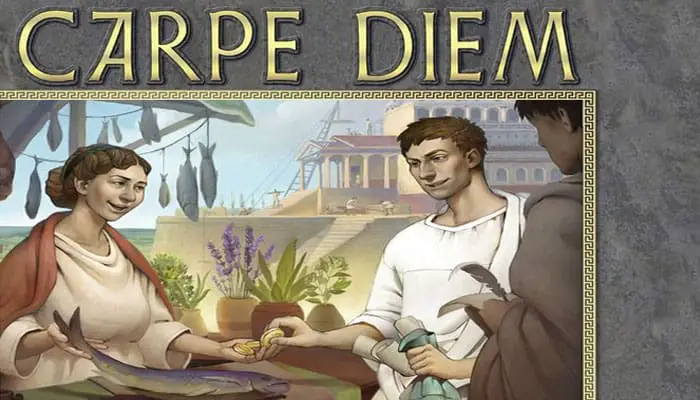
Rome, 1 B.C. As influential patricians, you set out to improve your city districts. Profitable buildings and beautiful landscapes will make sure your part of the city will prosper.
While you do, make sure to adhere to the motto of "carpe diem". Seize the day by harvesting grapes and catching fish, then sell these wares on the market to make money.
Build proper dwellings for your servants and they will be more diligent and more productive. And don't forget your own villa! It will gain you a lot of prestige.
Game Contents

- 1 game board
- 84 building tiles
- 39 building tiles
- 16 frame parts
- 24 gold coins
- 18 bread tokens
- 36 banderoles
- 1 starting player token
- 4 building boards
- 4 overview boards
- 60 scoring cards
- 24 fountain cards
- 66 victory point cards
- 4 meeples
- 20 discs
- 20 wares
Object of the Game
Turn by turn you will try to get various building tiles to add to your district, and build more and more buildings and landscapes. Over four scoring periods your accomplishments will be turned into victory points.
The player with the most victory points at the end of the game is the winner.
Setup
Before the first game, all pieces have to be carefully punched out of the boards. Place the game board in the center of the table.
Distribute to each player:
4 random frame parts - Assemble them piece by piece in random order into a square frame and place them in front of you.
1 random building board - Place it in the frame so that the shovel in the center is rotated toward you. This is your "city district". Your goal is to build on it in a way that gains you the most victory points.
9 banderoles - Distribute them on the nine banderole spaces on your building board.
1 overview board - Place it next to your district. This serves as quick reference for the main game rules and as storage for game materials.
1 meeple ("patrician") in a color of your choice. Place it on any of the seven semi-circular spaces in the center of the game board that is unoccupied.
5 wooden discs in the color of your meeple. Put them on your storage space for now.
Separate the 60 scoring cards into piles according to their backs, shuffle them, and put them next to the game board in four face down piles.


Take a number of cards from each pile, depending on the number of players (see sidebar), e.g. for 3 players, that's 2 A and 2 C cards, plus 3 B and 3 D cards.
These 8, 10 or 12 cards (for 2, 3 or 4 players) are shuffled thoroughly and placed one by one face up on the card spaces on the left side of the game board.
In a 2-player game, don't place any cards on the corner spaces. In a 3-player game, 2 opposing corner spaces stay empty. In a 4-player game, all 12 spaces are used.
Return the remaining scoring cards to the box, they won't be used this game.

Shuffle the 24 fountain cards and place them in a face down pile next to the game board.
Sort the 66 victory point cards into five piles according to their point value.
Separate the light and dark green building tiles, shuffle them and place them in face down piles next to the game board. Place four randomly selected light green building tiles on each large square blueprint tile space on the game board (= a total of 28 tiles).
Turn them all face up. Place one randomly selected dark green building tile on each of the square seal spaces on the bottom margin of the game board. Turn them all face up.
Place the 20 wares (5 each of grapes, herbs, fish, and chicken) as well as all coins and bread tokens next to the game board.

The player who was born farthest from 1 B.C. gets the starting player token. They put one of their 5 discs on the 0 space of the banderole bar in the top margin of the game board. The other players follow in clockwise order and place their discs on top of the others.
In addition, the starting player gets victory point cards with a total value of 8. In the 2-player game, the other player gets 9 victory points. In the 4-player game, the other players in turn order get 9, 10, and 11 victory points.
Attention: The 3-player game is special: The starting player gets 8 victory points, the next player 9, and the third player gets 13 victory points!

Game Play
The game consists of four phases of seven rounds each.
After each phase there is a scoring period. After the fourth scoring period, there is a final scoring period. This ends the game, and the player with the most victory points is the winner.
The starting player starts with their turn, then the other players follow in turn order. Once the last player has completed their turn, the current round ends. After exactly 7 rounds all 28 building tiles have been picked, and the phase ends.

Each turn, the current player moves their meeple onto one of the opposite semi-circular spaces. They pick one of the building tiles located on the adjacent blueprint space and immediately integrate it into their district.
"Opposite" spaces are connected to the original space by black lines. At the beginning of their next turn, the player moves from their current space along a black line to one of the two oppo- site spaces, and so on.
In addition, the following rules apply:
Meeples may move onto a space that is already occupied.
Meeples must be moved every turn, they cannot stay where they are.
After moving, the current player must select a tile. If they do not want to or cannot integrate that tile into their district, they place it face down on the storage space on their overview board, where it stays until the end of the game.
If - after a few rounds - a player moves onto a semi-circular space without a building tile next to it, they immediately move again until their meeple moves onto a space with at least one tile next to it. Each of these extra moves must follow the movement rules.
Attention! Important For The 2- And 3-player Games:
In the 2-player game, the two remaining building tiles are removed from a space as soon as the second tile has been picked.
In the 3-player game, the last remaining building tile is removed from a space as soon as the penultimate tile has been picked. Return the removed tiles to the box, they won't be used for the remainder of the game.
Players move their meeple for exactly seven rounds until all building tiles have been picked (or removed) from the game board and the first phase ends, followed by the first scoring period.
Building Rules
The first tile selected by a player must be placed on the shovel space. All sub- sequent tiles must be placed adjacent (not diagonally!) to a tile that is already on the building board. The frame does not count as a tile!
Tiles must be placed in a way that all its sides match each adjacent tile. There is no "top" or "bottom", you may rotate it as you like.
"Matching" means that every adjacent side to each other must match. Pond must touch pond, grass must touch grass, villa must touch villa, yellow dwel- ling must touch yellow dwelling, etc. Non-matching combinations are not allowed! The frame counts as 'grass', i.e. you may only put tiles with a grass side adjacent to a frame piece.
If a player places a building tile on a space with a banderole, they first remove the banderole completely from the game, then move their disc one space on the banderole bar. If that space is already occupied, they place their disc on top of the other disc(s).
In most cases, whenever a player completes a building or a landscape, they immediately get a reward. In addition, completed buildings and landscapes help during scoring and may gain additional victory points during the final scoring period at the end of the game (more info can be found on the over- view board).
 Wrong |
 Correct but Incomplete |
 Correct and Completed |
Villas

Villas can be any size. A completed villa consists of at least two adjacent tiles, where none of those tiles have an "opening".
Completing a villa doesn't grant a reward, but completed villas gain victory points at the end of the game. Players may own multiple complete and incomplete villas.
The Four Types of Landscape
A completed landscape consists of 2-4 tiles of the same type. Whenever a player completes a landscape, they are immediately rewarded with a one time bonus of wares from the supply.
The bonus is always the number of used tiles minus 1. Place the wares on your storage space. A player may own multiple complete and incomplete landscapes of any type and size.
Depending on the type of landscape, the player gets:


This 3-tile pond rewards 2 fish.
The Four Types of Dwellings
A dwelling always consists of exactly two halves of the same color. A player may own multiple complete and incomplete dwellings of any type. Whenever a player completes a dwelling, that player immediately receives a one-time bonus, depending on the roof color:
Merchant:


The player returns all their wares (fish, herbs, etc). to the supply and gets that many coins plus 1 additional coin from the supply. They place them on their storage space.
If that player doesn't own any wares to trade in, they just get the additional coin from the supply.
Example: Nick trades in 1 fish, 1 chicken, and 2 grapes and receives 5 coins.
During scoring, coins can be used as wildcards to replace any ware (fish, herb, etc).
Baker:


The player takes 2 bread tokens from the supply and puts them on their storage space. Bread can be used for two different purposes:
-

At the beginning of a player's turn, they may pay one bread token into the supply to move their meeple against the rules to any space (or remain where they are!) and pick a tile from there.
-

During scoring, a player may pay three bread tokens to fulfill the requirements of one of the two adjacent scoring cards.
That player receives the rewards of that card without meeting the actual requirements shown on the card. This is true for the "green" requirements (where you need to own something) as well as the "red" ones (where you have to pay something).
Note: If a player receives bread as a reward and then owns 3 bread, they may immediately use them during the same scoring period.
Administrator:


The player moves their disc two spaces on the banderole bar. If that space is occupied, put the disc on top.
Craftsman:


The player selects any one of the building tiles on the bottom margin of the game board and immediately integrates it into their district, following the building rules.
If that tile completes anything, they are rewarded accordingly. If they complete another craftsman dwelling, they select another tile, etc.
The building tiles on the bottom margin are not replaced with new tiles.
Markets / Bakeries / Fountains
Markets always consist of the single tile they are depicted on. The same applies to bakeries and fountains. They are always surrounded by grass, so they can only be placed adjacent to other grass.
-
Market:


When you place a market, you are rewarded one coin from the supply. Place it on your storage space.
More information about using coins can be found in "Dwellings: Merchant" and "The Scoring Cards".
-
Bakery:


When you place a bakery, you are rewarded one bread from the supply. Place it on your storage space.
More information about using bread can be found in "Dwellings: Baker" and "The Scoring Cards".
-
Fountain:


When you place a fountain, look at the top two cards of the face down fountain card pile. Pick one of them and place it face down next to your storage space. Put the other card face down under the fountain card pile
Attention: For each subsequent fountain you place during this game, you may keep both cards and return a card from an earlier fountain to the bottom of the fountain card pile.
Note: For the unlikely case that there aren't enough tokens for wares, bread, or coins, simply use other materials instead.
Scoring
After each player has completed their 7 turns, all 28 building tiles have been used up. The phase ends by scoring this round: The player who has progressed furthest on the banderole bar begins. If there is a tie, the player on top begins.

If it's your turn to score, place one of your discs on an empty circle space to trigger both adjacent scoring cards. After each player has placed one disc and triggered both cards, scoring ends and the next phase is prepared.
The scoring discs stay where they are, i.e. these spaces can't be used during subsequent scoring periods. Only the current disc triggers scoring of adjacent cards. Discs from previous scoring periods do not trigger, they just block that particular space.
Note: You always have one more space available than necessary for the number of players (9 spaces for 2 players, 13 spaces for 3 players, and 17 spaces for 4 players).

The Scoring Cards
There are two types of scoring cards:

For cards with green background, you must own whatever is shown in the top half of the card (e.g. three completed dwellings, or 2 villa chimneys, or . . ). to receive the rewards shown in the bottom half.

For cards with red background, you must pay the wares shown in the top half (or the same number of coins) to get the rewards.
The following applies to both types: If a player owns (or pays) multiples of whatever is shown on the card, they also receive the shown rewards that often (see examples below).
In addition, there are four types of cards: A, B, C, and D. They are pre- selected depending on the number of players (according to their backside) and then distributed randomly.

-
A and B Cards
These cards require you to pay a specific quantity of the same (A cards) or different wares (B cards). Any wares can be replaced by coins.
For example, these four cards read as follows:
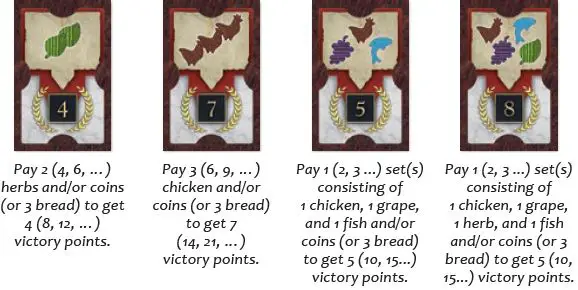
-
C Cards
These cards are affected by your villas.
Some have you count the total number of chimneys in your district. Every chimney counts, no matter if the villas are completed or not.
Other are only affected by completed villas (independent of their size!). Incomplete villas are ignored.
For example, these four cards read as follows:
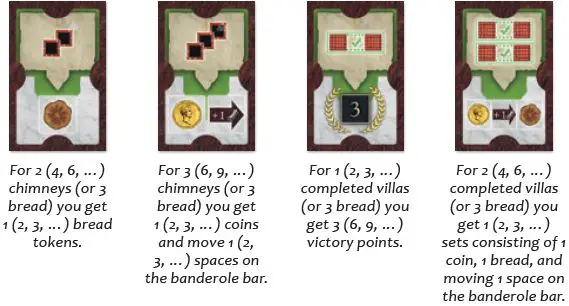
-
D Cards
These cards are affected by your landscapes, dwellings, as well as markets, bakeries, and fountains.
For example, these four cards read as follows:
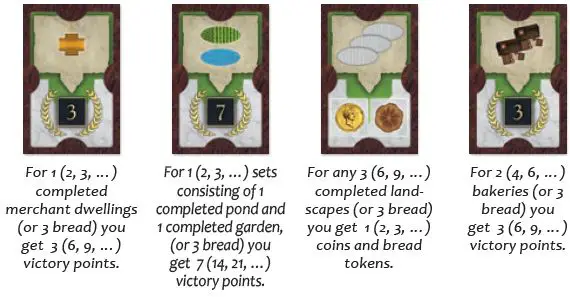
Important: If a player can't fully meet the requirements of a scoring card, they don't get any victory points at all and instead lose 4 victory points.That means that a player might lose up to 8 victory points during a scoring period!
Example: For one of her scoring cards, Sophie needs to pay 3 herbs, but she only owns 2. She neither owns coins nor 3 bread tokens. She keeps the 2 herbs, and instead of gaining 7 victory points, she loses 4 victory points.
Each player decides the order in which they fulfill their two scoring cards. Sometimes it is possible to fulfill the second scoring card with the rewards from fulfilling the first.
Subsequent Phases follow the same pattern:
-
In the second and third phases, distribute 28 light green building tiles on the seven blueprint spaces of the game board. In the fourth phase, distribute the remaining 28 dark green building tiles.
Note: As opposed to the light tiles, the dark tiles always only show exactly one thing.
-
Pass the starting player token to the left.
-
Scoring cards and banderole discs as well as meeples stay where they are.
End of the Game
The game ends after scoring the fourth phase, followed by the final scoring. For the final scoring period, follow the dark grey list on your overview boards:
-
Villas:
Count the chimneys in each of your completed villas and take the listed victory points. Incomplete villas and their chimneys are ignored.
Example: Nick has a completed villa with 3 chimneys and two completed villas with 5 chimneys each. He also owns two incomplete villas with 4 chimneys each: He receives 3+7+7+0+0=17 victory points.
-
Remaining Items:
Divide the number of remaining items on your storage space (wares, coins, bread tokens, and building tiles) by 2. You gain that many victory points, rounded down.
-
Banderole Bar:
You gain as many victory points as shown on the banderole bar space with your disc.
-
Fountain Cards:
Reveal your fountain cards. You gain that many victory points depending on your achievements. If you have both fountain cards of the same type, you get victory points for both of them.
For example, these four fountain cards read as follows:
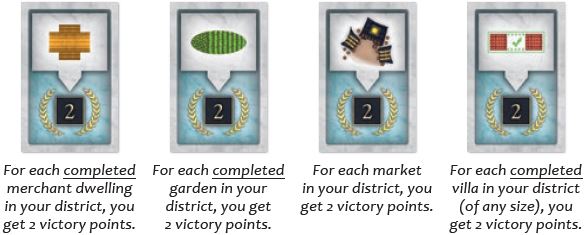
-
Frame Achievements:
Each player has two goals on each of their 4 frame parts. Frame achievements work as follows: Draw an imaginary line starting at the golden arrow that shows a building or landscape type.
That line must intersect with at least one completed building or landscape of that type. Incomplete or additional matching buildings or landscapes do not count.
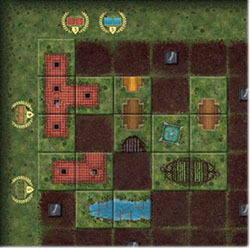
This player achieved the "baker dwelling" goal (1x 4 victory points) and the "villa" goal (1x 3 victory points), but not the "pond" and the "garden" goal.
The player with the most victory points is the winner.
If multiple players are tied for most victory points, the player among them who is last on the banderole bar wins the game.
Continue Reading
